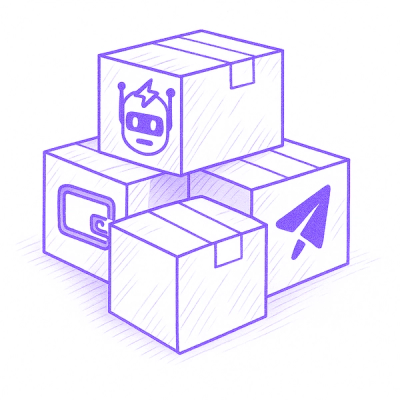
Research
Malicious npm Packages Impersonate Flashbots SDKs, Targeting Ethereum Wallet Credentials
Four npm packages disguised as cryptographic tools steal developer credentials and send them to attacker-controlled Telegram infrastructure.
use-places-autocomplete
Advanced tools
This is a React hook for Google Maps Places Autocomplete, which helps you build a UI component with the feature of place autocomplete easily! By leveraging the power of Google Maps Places API, you can provide a great UX (user experience) for user interacts with your search bar or form, etc. Hope you guys 👍🏻 it.
❤️ it? ⭐️ it on GitHub or Tweet about it.

⚡️ Try yourself: https://use-places-autocomplete.netlify.app
react.To use use-places-autocomplete, you must use react@16.8.0 or greater which includes hooks.
This package is distributed via npm.
$ yarn add use-places-autocomplete
# or
$ npm install --save use-places-autocomplete
When working with TypeScript you need to install the @types/google.maps as a devDependencies.
$ yarn add --dev @types/google.maps
# or
$ npm install --save-dev @types/google.maps
usePlacesAutocomplete is based on the Places Autocomplete (or more specific docs) of Google Maps Place API. If you are unfamiliar with these APIs, we recommend you review them before we start.
To use this hook, there're two things we need to do:
Use the script tag to load the library in your project and pass the value of the callback parameter to the callbackName option.
<script
defer
src="https://maps.googleapis.com/maps/api/js?key=YOUR_API_KEY&libraries=places&callback=YOUR_CALLBACK_NAME"
></script>
⚠️ If you got a global function not found error. Make sure
usePlaceAutocompleteis declared before the script was loaded. You can use the async or defer attribute of the<script>element to achieve that.
Now we can start to build our component. Check the API out to learn more.
import usePlacesAutocomplete, {
getGeocode,
getLatLng,
} from "use-places-autocomplete";
import useOnclickOutside from "react-cool-onclickoutside";
const PlacesAutocomplete = () => {
const {
ready,
value,
suggestions: { status, data },
setValue,
clearSuggestions,
} = usePlacesAutocomplete({
callbackName: "YOUR_CALLBACK_NAME",
requestOptions: {
/* Define search scope here */
},
debounce: 300,
});
const ref = useOnclickOutside(() => {
// When the user clicks outside of the component, we can dismiss
// the searched suggestions by calling this method
clearSuggestions();
});
const handleInput = (e) => {
// Update the keyword of the input element
setValue(e.target.value);
};
const handleSelect =
({ description }) =>
() => {
// When the user selects a place, we can replace the keyword without request data from API
// by setting the second parameter to "false"
setValue(description, false);
clearSuggestions();
// Get latitude and longitude via utility functions
getGeocode({ address: description }).then((results) => {
const { lat, lng } = getLatLng(results[0]);
console.log("📍 Coordinates: ", { lat, lng });
});
};
const renderSuggestions = () =>
data.map((suggestion) => {
const {
place_id,
structured_formatting: { main_text, secondary_text },
} = suggestion;
return (
<li key={place_id} onClick={handleSelect(suggestion)}>
<strong>{main_text}</strong> <small>{secondary_text}</small>
</li>
);
});
return (
<div ref={ref}>
<input
value={value}
onChange={handleInput}
disabled={!ready}
placeholder="Where are you going?"
/>
{/* We can use the "status" to decide whether we should display the dropdown or not */}
{status === "OK" && <ul>{renderSuggestions()}</ul>}
</div>
);
};
💡 react-cool-onclickoutside is my other hook library, which can help you handle the interaction of user clicks outside of the component(s).
Easy right? This is the magic of usePlacesAutocomplete ✨. I just showed you how it works via a minimal example. However, you can build a UX rich autocomplete component, like WAI-ARIA compliant and keyword interaction like my demo, by checking the code or integrating this hook with the combobox of Reach UI to achieve that.
import usePlacesAutocomplete from "use-places-autocomplete";
import {
Combobox,
ComboboxInput,
ComboboxPopover,
ComboboxList,
ComboboxOption,
} from "@reach/combobox";
import "@reach/combobox/styles.css";
const PlacesAutocomplete = () => {
const {
ready,
value,
suggestions: { status, data },
setValue,
} = usePlacesAutocomplete({ callbackName: "YOUR_CALLBACK_NAME" });
const handleInput = (e) => {
setValue(e.target.value);
};
const handleSelect = (val) => {
setValue(val, false);
};
return (
<Combobox onSelect={handleSelect} aria-labelledby="demo">
<ComboboxInput value={value} onChange={handleInput} disabled={!ready} />
<ComboboxPopover>
<ComboboxList>
{status === "OK" &&
data.map(({ place_id, description }) => (
<ComboboxOption key={place_id} value={description} />
))}
</ComboboxList>
</ComboboxPopover>
</Combobox>
);
};
When loading the Google Maps Places API via a 3rd-party library, you may need to wait for the script to be ready before using this hook. However, you can lazily initialize the hook in the following ways, depending on your use case.
import usePlacesAutocomplete from "use-places-autocomplete";
const App = () => {
const { init } = usePlacesAutocomplete({
initOnMount: false, // Disable initializing when the component mounts, default is true
});
const [loading] = useGoogleMapsApi({
library: "places",
onLoad: () => init(), // Lazily initializing the hook when the script is ready
});
return <div>{/* Some components... */}</div>;
};
import usePlacesAutocomplete from "use-places-autocomplete";
const PlacesAutocomplete = () => {
const { ready, value, suggestions, setValue } = usePlacesAutocomplete();
return <div>{/* Some components... */}</div>;
};
const App = () => {
const [loading] = useGoogleMapsApi({ library: "places" });
return (
<div>
{!loading ? <PlacesAutocomplete /> : null}
{/* Other components... */}
</div>
);
};
By default, this library caches the response data to help you save the cost of Google Maps Places API and optimize search performance.
const methods = usePlacesAutocomplete({
// Provide the cache time in seconds, the default is 24 hours
cache: 24 * 60 * 60,
});
By the way, the cached data is stored via the Window.sessionStorage API.
You may need to have multiple caches. For example, if you use different place type restrictions for different pickers in your app.
const methods = usePlacesAutocomplete({
// Provide a custom cache key
cacheKey: "region-restricted",
});
Note that usePlacesAutocomplete will prefix this with
upa-, so the above would becomeupa-region-restrictedin sessionStorage.
const returnObj = usePlacesAutocomplete(parameterObj);
When using usePlacesAutocomplete, you can configure the following options via the parameter.
| Key | Type | Default | Description |
|---|---|---|---|
requestOptions | object | The request options of Google Maps Places API except for input (e.g. bounds, radius, etc.). | |
googleMaps | object | window.google.maps | In case you want to provide your own Google Maps object, pass the google.maps to it. |
callbackName | string | The value of the callback parameter when loading the Google Maps JavaScript library. | |
debounce | number | 200 | Number of milliseconds to delay before making a request to Google Maps Places API. |
cache | number | false | 86400 (24 hours) | Number of seconds to cache the response data of Google Maps Places API. |
cacheKey | string | "upa" | Optional cache key so one can use multiple caches if needed. |
defaultValue | string | "" | Default value for the input element. |
initOnMount | boolean | true | Initialize the hook with Google Maps Places API when the component mounts. |
It's returned with the following properties.
| Key | Type | Default | Description |
|---|---|---|---|
ready | boolean | false | The ready status of usePlacesAutocomplete. |
value | string | "" | value for the input element. |
suggestions | object | { loading: false, status: "", data: [] } | See suggestions. |
setValue | function | (value, shouldFetchData = true) => {} | See setValue. |
clearSuggestions | function | See clearSuggestions. | |
clearCache | function | (key = cacheKey) => {} | Clears the cached data. |
init | function | Useful when lazily initializing the hook. |
The search result of Google Maps Places API, which contains the following properties:
loading: boolean - indicates the status of a request is pending or has been completed. It's useful for displaying a loading indicator for the user.status: string - indicates the status of the API response, which has these values. It's useful to decide whether we should display the dropdown or not.data: array - an array of suggestion objects each contains all the data.Set the value of the input element. Use the case below.
import usePlacesAutocomplete from "use-places-autocomplete";
const PlacesAutocomplete = () => {
const { value, setValue } = usePlacesAutocomplete();
const handleInput = (e) => {
// Place a "string" to update the value of the input element
setValue(e.target.value);
};
return (
<div>
<input value={value} onChange={handleInput} />
{/* Render dropdown */}
</div>
);
};
In addition, the setValue method has an extra parameter, which can be used to disable hitting Google Maps Places API.
import usePlacesAutocomplete from "use-places-autocomplete";
const PlacesAutocomplete = () => {
const {
value,
suggestions: { status, data },
setValue,
} = usePlacesAutocomplete();
const handleSelect =
({ description }) =>
() => {
// When the user selects a place, we can replace the keyword without requesting data from the API
// by setting the second parameter to "false"
setValue(description, false);
};
const renderSuggestions = () =>
data.map((suggestion) => (
<li key={suggestion.place_id} onClick={handleSelect(suggestion)}>
{/* Render suggestion text */}
</li>
));
return (
<div>
<input value={value} onChange={handleInput} />
{status === "OK" && <ul>{renderSuggestions()}</ul>}
</div>
);
};
Calling the method will clear and reset all the properties of the suggestions object to default. It's useful for dismissing the dropdown.
import usePlacesAutocomplete from "use-places-autocomplete";
import useOnclickOutside from "react-cool-onclickoutside";
const PlacesAutocomplete = () => {
const {
value,
suggestions: { status, data },
setValue,
clearSuggestions,
} = usePlacesAutocomplete();
const ref = useOnclickOutside(() => {
// When the user clicks outside of the component, call it to clear and reset the suggestions data
clearSuggestions();
});
const renderSuggestions = () =>
data.map((suggestion) => (
<li key={suggestion.place_id} onClick={handleSelect(suggestion)}>
{/* Render suggestion text */}
</li>
));
return (
<div ref={ref}>
<input value={value} onChange={handleInput} />
{/* After calling the clearSuggestions(), the "status" is reset so the dropdown is hidden */}
{status === "OK" && <ul>{renderSuggestions()}</ul>}
</div>
);
};
We provide getGeocode, getLatLng, getZipCode, and getDetails utils for you to do geocoding and get geographic coordinates when needed.
It helps you convert address (e.g. "Section 5, Xinyi Road, Xinyi District, Taipei City, Taiwan") into geographic coordinates (e.g. latitude 25.033976 and longitude 121.5645389), or restrict the results to a specific area by Google Maps Geocoding API.
In case you want to restrict the results to a specific area, you will have to pass the address and the componentRestrictions matching the GeocoderComponentRestrictions interface.
import { getGeocode } from "use-places-autocomplete";
const parameter = {
address: "Section 5, Xinyi Road, Xinyi District, Taipei City, Taiwan",
// or
placeId: "ChIJraeA2rarQjQRPBBjyR3RxKw",
};
getGeocode(parameter)
.then((results) => {
console.log("Geocoding results: ", results);
})
.catch((error) => {
console.log("Error: ", error);
});
getGeocode is an asynchronous function with the following API:
parameter: object - you must supply one, only one of address or location or placeId and optionally bounds, componentRestrictions, region. It'll be passed as Geocoding Requests.results: array - an array of objects each contains all the data.error: string - the error status of API response, which has these values (except for "OK").It helps you get the lat and lng from the result object of getGeocode.
import { getGeocode, getLatLng } from "use-places-autocomplete";
const parameter = {
address: "Section 5, Xinyi Road, Xinyi District, Taipei City, Taiwan",
};
getGeocode(parameter).then((results) => {
const { lat, lng } = getLatLng(results[0]);
console.log("Coordinates: ", { lat, lng });
});
getLatLng is a function with the following API:
parameter: object - the result object of getGeocode.latLng: object - contains the latitude and longitude properties.error: any - an exception.It helps you get the postal_code from the result object of getGeocode.
import { getGeocode, getZipCode } from "use-places-autocomplete";
const parameter = {
address: "Section 5, Xinyi Road, Xinyi District, Taipei City, Taiwan",
};
getGeocode(parameter)
// By default we use the "long_name" value from API response, you can tell the utility to use "short_name"
// by setting the second parameter to "true"
.then((results) => {
const zipCode = getZipCode(results[0], false);
console.log("ZIP Code: ", zipCode);
});
getZipCode is a function with the following API:
parameters - there're two parameters:
1st: object - the result object of getGeocode.2nd: boolean - should use the short_name or not from API response, default is false.zipCode: string | null - the zip code. If the address doesn't have a zip code it will be null.error: any - an exception.Retrieves a great deal of information about a particular place ID (suggestion).
import usePlacesAutocomplete, { getDetails } from "use-places-autocomplete";
const PlacesAutocomplete = () => {
const { suggestions, value, setValue } = usePlacesAutocomplete();
const handleInput = (e) => {
// Place a "string" to update the value of the input element
setValue(e.target.value);
};
const submit = () => {
const parameter = {
// Use the "place_id" of suggestion from the dropdown (object), here just taking the first suggestion for brevity
placeId: suggestions[0].place_id,
// Specify the return data that you want (optional)
fields: ["name", "rating"],
};
getDetails(parameter)
.then((details) => {
console.log("Details: ", details);
})
.catch((error) => {
console.log("Error: ", error);
});
};
return (
<div>
<input value={value} onChange={handleInput} />
{/* Render dropdown */}
<button onClick={submit}>Submit Suggestion</button>
</div>
);
};
getDetails is an asynchronous function with the following API:
parameter: object - the request of the PlacesService's getDetails() method. You must supply the placeId that you would like details about. If you do not specify any fields or omit the fields parameter you will get every field available.placeResult: object | null - the details about the specific place your queried.error: any - an exception.⚠️ warning, you are billed based on how much information you retrieve, So it is advised that you retrieve just what you need.
💡 If you have written any blog post or article about
use-places-autocomplete, please open a PR to add it here.
Thanks goes to these wonderful people (emoji key):
Welly 💻 📖 🚧 | Kyle 🌍 | Lazar Karić 💻 📖 | Raif Harik 💻 📖 🤔 | Xerxes Jarquin 🐛 | Lucas O'Connell 📖 | Keven Jesus 🐛 |
Vinicius Uehara 📖 | Damon 💻 | Matthew Marcus 💻 | Chris Sandvik 💻 | Thomas Yee 📖 |
This project follows the all-contributors specification. Contributions of any kind are welcome!
FAQs
React hook for Google Maps Places Autocomplete.
The npm package use-places-autocomplete receives a total of 129,445 weekly downloads. As such, use-places-autocomplete popularity was classified as popular.
We found that use-places-autocomplete demonstrated a not healthy version release cadence and project activity because the last version was released a year ago. It has 1 open source maintainer collaborating on the project.
Did you know?

Socket for GitHub automatically highlights issues in each pull request and monitors the health of all your open source dependencies. Discover the contents of your packages and block harmful activity before you install or update your dependencies.

Research
Four npm packages disguised as cryptographic tools steal developer credentials and send them to attacker-controlled Telegram infrastructure.

Security News
Ruby maintainers from Bundler and rbenv teams are building rv to bring Python uv's speed and unified tooling approach to Ruby development.

Security News
Following last week’s supply chain attack, Nx published findings on the GitHub Actions exploit and moved npm publishing to Trusted Publishers.